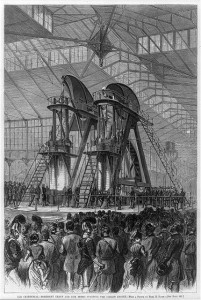
The Corliss Engine, a symbol of industrial power, became a symbol of the Centennial Exhibition held in Philadelphia in 1876.
World’s fairs, the enormously popular spectacles that began in the middle of the nineteenth century and continue in lesser forms today, provide a rich body of evidence for investigating the cultures and ideologies of their times. This course will reach beyond the popular veneer of world’s fairs – the Ferris wheel, the ice cream cone, the Eiffel Tower – to investigate the deeper implications of these major events, especially the ways in which they reveal the dynamics of empire. By examining the displays of arts, architecture, manufactures, and people at world’s fairs, we will gain a better understanding of world history from the time of the first fair, the Crystal Palace Exhibition in London in 1851, to the forthcoming Expo Milano to be held in 2015. Our investigation will span regions of the world subjected to colonization, such as Africa and Southeast Asia, as well as imperial powers such as Great Britain and the United States. This will lead to engagement with issues such as international relations; race; gender; and power.
Students who enroll in this course should expect an active-learning experience. There will be opportunities for individual investigation as well as structured group activities. Through these, students will gain skills in locating sources in their original form and online; analyzing artifacts as well as texts; and communicating findings with others. Options for digital projects will be available (but no previous experience will be necessary, and training will be provided).
Books will include:
Douglas Northrop, An Imperial World: Empires and Colonies Since 1750 (Pearson, 2013).
Laura Hollengreen et. al., Meet Me at the Fair: A World’s Fair Reader. This book is available as a free download or may be ordered through Amazon.com. For the free download, link here and scroll to the bottom of the page for the PDF.